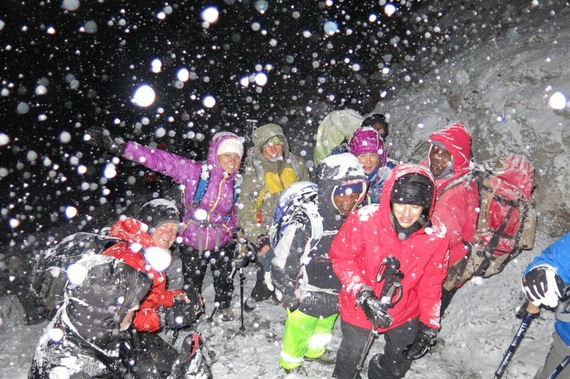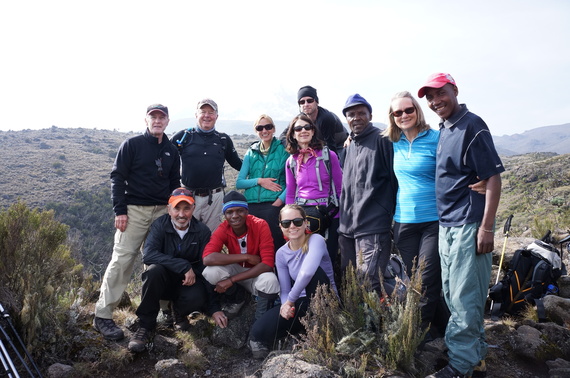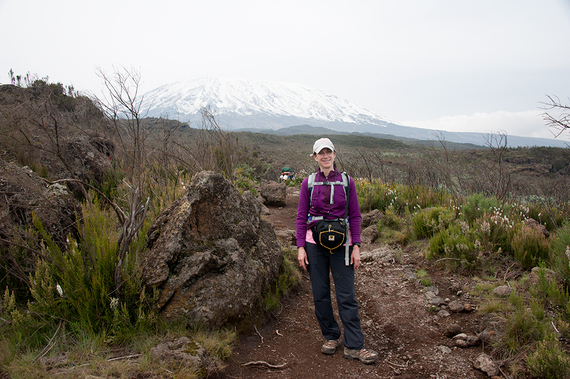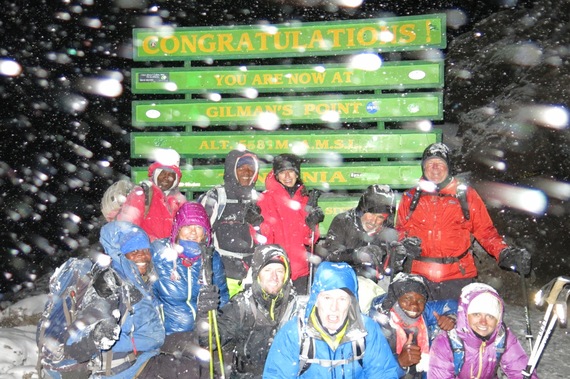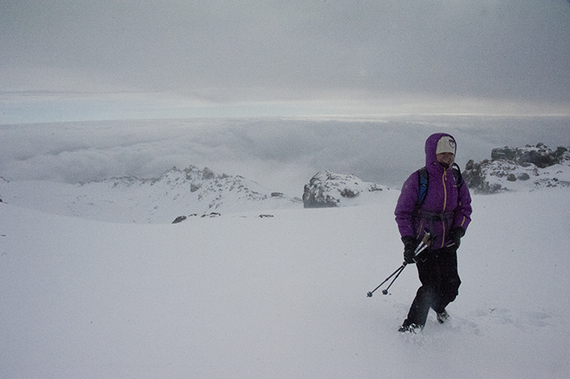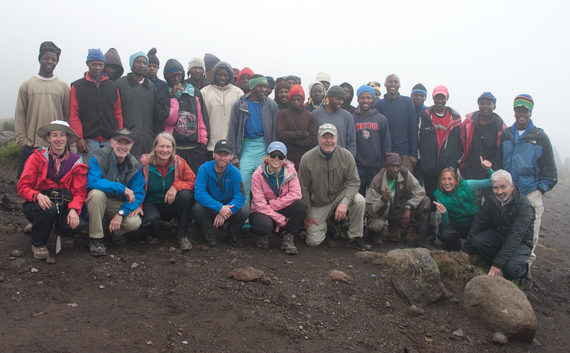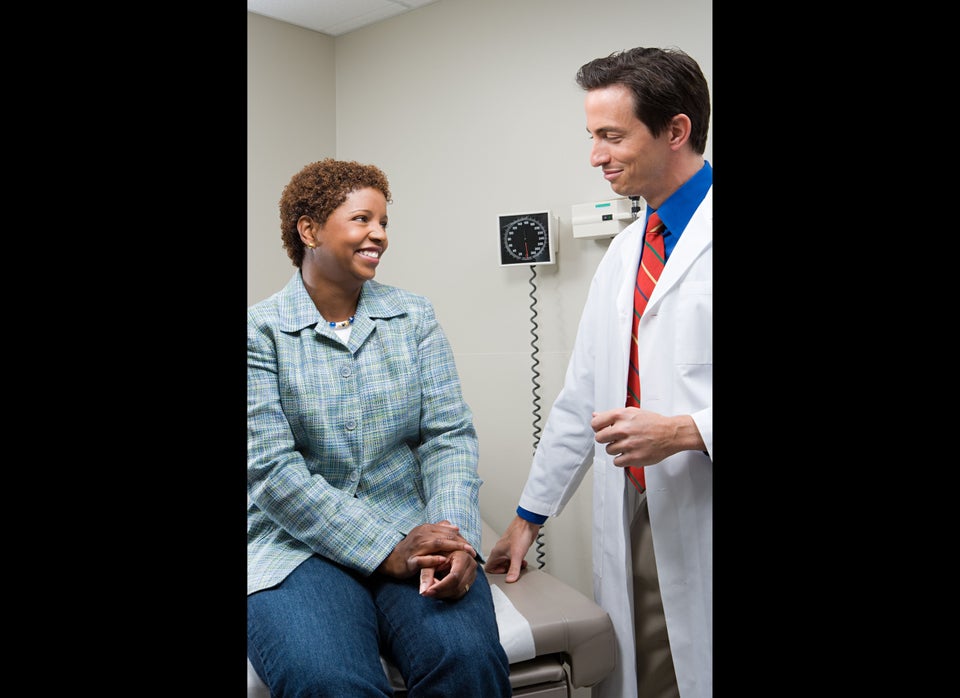My dream of summiting Mt. Kilimanjaro almost ended an hour after the push for the top began. Our group of seven trekkers (ranging in age from 24 to 67) and four guides had been on the mountain for five days, mastering a shuffle known as pole, pole (pronounced pole-ay, pole-ay) -- "slowly, slowly" in Swahili. Starting in potato fields and cornfields on the remote Rongai route, we measured our days in hours hiked and elevation gained, not in miles or kilometers traveled. From the very beginning we had to march in line behind Johnny, a local guide whose footsteps were so precise and methodical, no matter what the terrain, that we soon adopted his glacial pace. The name of the game was acclimatization -- tricking our bodies into producing more red blood cells so that we could withstand what would be a withering slog to the oxygen-deprived summit at Uhuru Peak (19,341 feet) on summit day.

Emily hiking on Day 2
Even from our hotel in Moshi -- more than two hours away by car -- we could see the snow-covered dome of Kilimanjaro, monumental and intimidating. As we drove to the trailhead, there it was again, a stunning backdrop to the little villages nestled below. On the second day of hiking, it towered beyond the grasslands, a little closer but still distant enough that it seemed mind-boggling that I might climb it.
front row: Ballard Smith, Johnny (guide and pacesetter), Lauren Halstead
back row: Lee McCollum, Michael Halstead, Billi Bierling (lead guide), Emily Kelting (author), Andrew McCollum, Alex (guide), Sally Halstead, Benson (guide). Not pictured: Ian Minja, lead guide.
At the Second Cave we veered left, away from the round dome of Mt. Kilimanjaro (also known as Kibo) to face Mawenzi Peak, whose snow-covered top looked as jagged as the back of a stegosaurus. "No one can climb to the top of Mawenzi," our guide Billi said. "The mountain is literally crumbling. It is too dangerous."
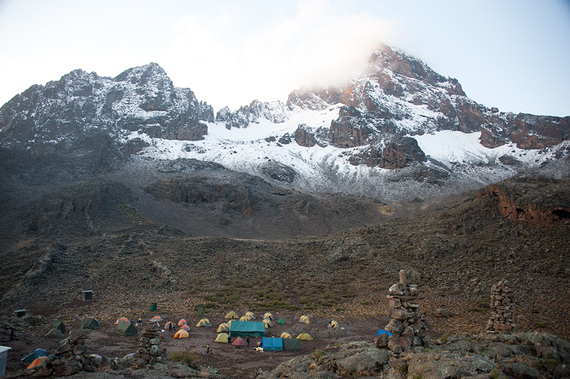
Our campsite at Mawenzi
Porters carrying unbelievably heavy and bulky loads on their backs and heads passed us. By the time we stumbled into the next camp, the portable toilet tent, the cook tent and dining tent, and our orange and gray sleeping tents were set up with our duffel bags inside (we carried a day pack with cameras, snacks, rain gear, and lunch boxes).
Bahati, the waiter, brought in bowls of hot soup, then platters of delicious chicken, pasta, or fish, accompanied by plantains, potatoes, tomatoes, and cucumbers. We added Nido (powdered milk) to our tea, instant coffee, and hot chocolate. There was porridge, omelets, sausage or bacon, and toast every day for breakfast, and pancakes (crêpes), too. My favorite meal was a thick vegetable stew served on the last night, accompanied by the delicious crêpes.
"You may lose your appetite at high altitudes," Billi said. One of our group was so nauseated he couldn't eat anything but Power Bars, but I never lost my appetite. Even though I ate and ate, I still lost 10 pounds by the end of the trip.
Before leaving for Africa, my greatest fear had been altitude sickness -- nausea, vomiting, splitting headaches. (In rare cases, climbers develop a more severe form -- dangerous swelling of the lungs, brain, or feet.)
I had trained by climbing mountains in Colorado and New England, hiking the Inca Trail in Peru, and hitting the StairMaster at the gym hard. Fitness doesn't figure into whether you will or won't get sick. Some people mysteriously get it, others don't. It could happen at 12,000 feet, 14,000 feet, or higher.
No additional oxygen was available. If we got sick, we'd have to go down with one of the guides to a lower elevation. Altitude sickness is the main reason that 40 to 50 percent of climbers don't make the summit.
On the fifth morning we hiked across a barren plateau known as "The Saddle," with Kibo rising up in the distance. At about 1 p.m., we arrived at our highest camp, near the Kibo Huts (15,466 feet). Still no sign of altitude sickness. Yippee!
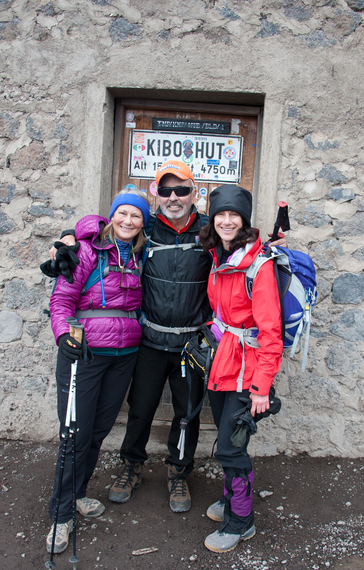
Sally Halstead, Ballard Smith and Emily Kelting at Kibo campsite
At 5 p.m., dinner was served -- heaping plates of spaghetti. After dinner, everyone but me caught a few hours of shuteye before the wake-up call at 10 p.m. (The reason given for the late evening departure was that by leaving at 11 PM we would catch a beautiful sunrise at the summit at dawn.) I was too excited and nervous to sleep. After all the months of planning and training, and five days on the mountain, it was now time to leave for the summit.
It seemed like a perfect night when we left the campsite at 11 p.m. -- a full moon to light our way, a star-spangled sky so close you could almost touch it. The air was cold, but not too much below freezing. We were all looking forward to seeing a beautiful sunrise when we reached the summit the next morning.
An hour in, I was feeling the effects of no sleep, not eating for seven hours, overheating with too many layers, and an urgent need to use the toilet.
Billi stayed with me as I squatted to relieve myself behind a rock. As the group moved ahead, she reached into my backpack for a Snickers bar and helped me take off my down parka. Born in Germany, Billi had climbed Everest and now lives in Nepal. How did I get so lucky as to have a world-class mountaineer by my side? "You are going to make this," she told me as I drooped, already exhausted, over my trekking poles.
At Hans Meyer Cave (17,245 feet), Billi directed me to sit on a rock at the back of the cave. I felt better after drinking more water and finishing off a protein bar. But soon after we left the cave, all hell broke loose.
The moon and stars disappeared. The sky shook with thunder and lightning. A fierce wind kicked up. Snow fell sideways and froze onto our faces. We turned on our headlamps so that we could see in the dark.
The trail vanished, and the angle of ascent became absurdly steep. I could barely see the foot of the person in front of me. "Breathe in, step, breathe out, step," Billi advised. Negotiating the 37 switchbacks, up and around huge boulders, gaining almost 4,000 feet in elevation from Kibo Huts to the summit at Uhuru Peak, undid many a climber in the best of conditions. And these were quickly becoming the worst.
By 5 a.m. we had reached Gilman's Point (18,763 feet), on the edge of the crater rim. It was still pitch dark. "Another reason we start at night is so that you don't see the switchbacks," guide Billi said. "If you had seen how steep it is, you wouldn't go up." Up on the rim, the wind hit us full force, 40 to 50 miles an hour, driving the snow into our faces. We couldn't see a path, or how close we were to falling down into the crater below. Quickly posing for a group photo in front of the sign, we couldn't stop for long. It was supposed to be another 90 minutes around the crater rim to the summit.
Snowdrifts reached to the top of my thighs. I put on a balaclava (head and face mask) and pulled down my black hat to leave only my eyes exposed. I looked like Darth Vader, but I didn't care. This wasn't a beauty contest. I was in survival mode.
I gave silent thanks to Renuka, a lovely Indian lady I had hiked with about two weeks before leaving for Africa. She had climbed Kili two years before.
"Bring your warmer snow boots for the last day," she advised.
My feet, I now realized, would have been completely frostbitten if I had worn my regular hiking boots. As it was, my hands were trying to extract the last bit of warmth left from a hand warmer, and were quickly going numb.
Holding one mitten to the side of my face, I tried to walk sideways so the wind wouldn't drive the snow in. We stopped and rested, leaning against a huge boulder, temporarily out of the wind. I reached into my pocket, and my fingers grasped a ceramic heart and prayer card, given to me by wonderful friends back home. Closing my eyes, I felt the spirits of my fellow parishioners at St. Mark's Church, where I had asked to be put on the prayer list on summit day.
I kept praying that the snow and wind would end, but it hammered us for nine hours. What if one of us falls and twists an ankle? I wondered. Even though I had trained for months with this goal in mind, I couldn't help but ask myself, "What is a 60 year-old Connecticut suburbanite doing in a place like this?"
We slogged on. The snow-filled sky finally began to lighten at about 7 a.m. My friend Sally was suffering. She couldn't feel her hands, her legs were shaking, and she said she couldn't go on. Ice clung to her hair and hat. "We are going to continue," Ian, the other lead guide, said in his quiet, confident way.
Off on the left, we could see huge rectangular slabs of blue-green ice -- the glaciers. Ian pointed down into the snow-filled crater, where we could just make out the tents and campsites of people who had slept there the night before.
The trail became wider. We passed people coming down from the summit. "You're close," they said, their faces as blue-green as the glaciers.
We weren't close.
One group coming down included a woman who had only one leg. and was using crutches. Then came a man with two prosthetic legs. Was I hallucinating? "They've come up from the crater this morning," Ian said. "They haven't come as far as you today to get to the summit."
Yes, but they somehow had made it up to the crater, which meant at least four days of hiking. Seeing them gave me new strength. If they could do this, so could I.
I put my arm around Sally to keep her steady. as we counted our steps, heads down.
At 7:45 a.m., I spotted the green sign: "Congratulations, you have reached Uhuru Peak." I went up and kissed it, breathing a huge sigh of relief. The walk around the crater rim, which should have taken 90 minutes, had taken almost three hours.
I didn't leap joyfully into the air, as I had the previous July when I reached "Deadwoman's Pass," the highest point on the Inca Trail in Peru. But Lauren, Sally's daughter, and I danced, singing "Pole, Pole" to the tune of the old Sam the Sham and the Pharoahs song, "Woolly Bully."
Out of my backpack, I grabbed my sunglasses and sunscreen -- which I never thought I would need. But we were above the clouds, and the sun at 18,000 feet was scorching. All of us burned our lips, and mine were the worst. If I looked frightening in my Darth Vader mask, I really looked awful for the next week, with blisters swelling my bottom lip to twice its size.
Strong winds still whipped up the snow, and now we could see how close we had been to the crater's edge. It was a miracle that none of us fell into it. The top of Mawenzi Peak appeared on the right, emerging from a bank of clouds below us. I truly felt as if I were on top of the world, or at least on the rooftop of Africa. I had reached the summit under the harshest of conditions. I had climbed Kilimanjaro.
Despite my early setback, I was the first of our group to reach the summit and the first to return to Kibo camp, more than 13 hours after we had left. On the way down, I could finally see the 37 switchbacks from Gilman's Point to Hans Meyer Cave. Billi was right -- if I had seen it in the light, I probably would have given up.
After lunch and a short rest stop at the Kibo camp, I literally skipped down the "Marangu Route" (known as the "Coca Cola route" for its wide path and popularity) for four hours to the Horombo campsite (12,200 feet), where Sally and I would spend our final night in our cramped tent. On summit day, we had ascended almost 4,000 feet. and descended another 7,200 feet -- hiking (with only a break for lunch) for close to 19 hours on no sleep. I was never so glad to see my sleeping bag. I popped an ibuprophen to soothe my aching body and was out like a light.
"Jambo, jambo bwana" ("hello, hello good friend"), the 23 porters and guides sang to us the next morning, our last on the mountain, as Billi handed out the gratuities. We shook hands with each of them, looking into their eyes, and saying a heartfelt Asante sana ("Thank you very much"). Without these extraordinary people, we couldn't have made it safely up and down Kilimanjaro. Getting to know them was truly a highlight of our journey.
We still had another seven hours to hike through moorland filled with wildflowers and then a lush tropical rain forest, through mud-and-stone-filled gullies, down, down down the Marangu route to the gate at the bottom. As I settled into my seat in the Land Cruiser for the ride back to Moshi, my muscles were still twitching, while my spirit soared.* I had been to the top of the mountain and made it back down. And when we reached Moshi, there would be a long, hot shower in my future.
*With my climb, I had raised over $3,500 for the Touch Foundation, which is building medical schools and treating local Tanzanians. I'm still trying to reach my fundraising goal of $5,895 (the height of Kilimanjaro in meters). http://www.crowdrise.com/climbfortouchfoundation/fundraiser/emilykelting
This article first appeared in Women's Voices for Change.
www.womensvoicesforchange.org.
Earlier on Huff/Post50:
